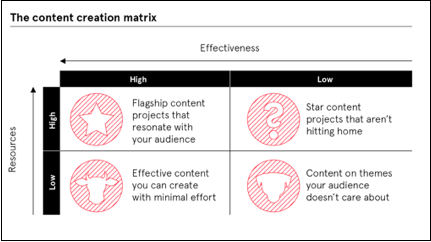What Does a Great Blog look like?
Time to read: 3 minutes
So you’re a B2B Tech firm and your marketing team has agreed that a blog is the way forward (and indeed it is). This is the blog you need to read next. Sandra Vogel, who heads up tech content for The Crowd and ghost blogs for a range of firms, passes on her advice.
 So what does a great blog look like? The answer depends on what you want to get out of a blog, so for the sake of argument let’s say you run a business that sells goods or services. There’s a lot of competition for whatever it is you do, and you need to remind people you exist. You use a range of different methods to do this – a blog on your web site is part of the mix.
So what does a great blog look like? The answer depends on what you want to get out of a blog, so for the sake of argument let’s say you run a business that sells goods or services. There’s a lot of competition for whatever it is you do, and you need to remind people you exist. You use a range of different methods to do this – a blog on your web site is part of the mix.
To meet the requirements of your business, your blog needs to keep people coming back. It’s a tool for you to deliver useful information to existing and potential customers or clients. It’s a way of showing off your organisational personality. And it’s a way of helping people understand more about your products, new launches, upgrades, exciting ideas and plans you have for the business.
That’s a lot for a blog to do. Here are some guidelines for better blogging:
- Keep it short. In general try for no more than 600 to 700 words. People will get bored if they have to read more than that, and you might easily stray off the topic at hand.
- Keep it simple. Don’t try to cram all your wisdom into a single blog. Have a point to make, make it, expand a little, maybe give some examples. Develop your point of course, but be careful not to make things too complex.
- Do you need a call to action? I see some blogs that include a call to action every single time. As a reader I know how the blog will end – it’ll be ‘now go and look at our great product’. If that happens every time readers know a blog is a glorified advertisement. They’ll get bored, go away, and maybe never come back. Calls to action are important. But you probably don’t need one in every blog.
- Connect well with the rest of the site. Do you publish white papers, news releases, new product updates? Of course you do. Tie blogs in so that there is continuity, and so you can link to other resources where possible. Don’t leave the blog out on a limb.
- It’s a good idea to have a forward plan so that you don’t get to ‘blog day’ and sit staring at a blank screen wondering what to write. If you work with an agency – and that’s a really sensible idea – then they’ll help with this.
- Be regular. It’s a good idea to have a schedule. Perhaps you want to put a new post online every two weeks. If that’s what you want to do, stick to it. When you make your plan (above), make your schedule too. Both plan and schedule can change in the light of events, but if they’re not in place a blog is the kind of thing that an organisation can let slip if it is busy. A blog that’s not up to date is arguably worse than no blog at all.
- Look from the outside in. Visitors might not use your product or service, might not know your business at all, might just be passing by. Think about it from their point of view. This can be hard to do in-house. It’s another area where an agency can be really helpful.
There’s another guideline that’s overarching on all of the above. It’s about the writing quality. The tone, writing style, grammatical accuracy and readability of your blog speaks volumes – it’s probably more important than the content. Really. You might have the most fantastic point to make, but if the message is garbled, nobody is going to get to the bottom of the screen.
If a blog is going to work for you, you need to put energy, effort and expertise into it. Writing a blog is hard work, and it is a skill people learn and hone through years of experience. Ensuring that the blog plan and schedule are well managed and that topics are spot-on can also be tricky in a busy business. There is no shame in lacking the skills or the time that’s needed in-house. Bringing them in from outside can take your business blog to the next level.
Five tips for Building a Solid Content Marketing Plan
Time to read: 3 minutes
Lauren Bowden, who looks after FinTech Content Marketing here at The Crowd, draws on her in-house experience to outline the foundations of a solid content marketing plan.
 I moved into a content marketing role around six years ago after a decade as a PR practitioner, and while certain aspects of the two disciplines were very similar – story crafting, messaging, creativity, etc. – my eyes were fully opened to the commercial side of the business and how the various parts of an organisation fit together. Earlier this year I was asked to be one of 11 content marketing experts to participate in an eBook on ‘using the content lifecycle to maximise content ROI’. Below is a summary of my contribution, with some additional insight I have gathered recently.
I moved into a content marketing role around six years ago after a decade as a PR practitioner, and while certain aspects of the two disciplines were very similar – story crafting, messaging, creativity, etc. – my eyes were fully opened to the commercial side of the business and how the various parts of an organisation fit together. Earlier this year I was asked to be one of 11 content marketing experts to participate in an eBook on ‘using the content lifecycle to maximise content ROI’. Below is a summary of my contribution, with some additional insight I have gathered recently.
1. Pool your knowledge
The FinTech sales cycle can easily take around 18 months and usually involves a plethora of decision-makers that marketeers need to know all about in order to best target their content marketing campaigns. It requires serious teamwork and buy-in from all key stakeholders, not just the sales team who often are positioned as the only conduit to the client and therefore the main go-to for marketing. Professional services team members have invaluable on-the-ground insight into the daily dealings at client sites, while product management ideally has a macro view of the industry and can point to future trends, so tapping into their knowledge is crucial when devising a content marketing plan.
2. Do your research
It is rare that only one product or solution will need to be pushed to the market through the course of the year and so content marketing plans should be drawn up for each area of focus. Some plans will be more detailed than others to reflect the organisation’s priorities, but at the very least they should cover information on market drivers, solution description, key messages, target market, buyers’ journey mapping, key competitors, challenges, localisation plans and a content calendar. This will take time but always pays dividends when it comes to managing workloads and budget effectively, and ultimately measuring effectiveness over the year.
3. Plan well – but leave some room to wiggle
Budgeting requires you to have a clear idea of the goals you need to achieve in each campaign—goals that have been communicated to and accepted by stakeholders. This does not mean planning and budgeting for every detail of every content piece with no wiggle room over the year. Even the most robust plan and organised team will have unexpected opportunities that are too good to pass up over the year. That’s why it’s always important to have at least a 10 percent contingency built into the budget.
Another benefit of a strong content plan is that it helps you manage supplier costs. With a well-thought-out plan, many items can be budgeted for upfront, suppliers notified in advance about what work you have planned over the year, and packages negotiated accordingly, giving you a bigger bang for your buck.
It is also crucial to keep up to date with your existing suppliers’ new offerings, and to explore the marketplace for other suppliers who can help you execute new tactics. This kind of market scanning is particularly important for in-house marketing teams so they can keep abreast of the latest techniques and methods.
4. Embrace the data
Making sure you’re hitting the right audiences with your content can be a challenge, especially when you are targeting multiple stakeholders who make decisions as a group. When you look back on this kind of win, it’s difficult to pinpoint the influence specific content pieces had on that sale. You’re not going to turn around to a salesperson after an 18-month-long sales process and tell her the real reason she got that deal was because of a video or white paper – unless you want to be laughed out of the sales meeting.
Marketing Technology (aka MarTech) can be your best friend here. Whether it’s CRM, marketing automation or content management systems, they can be crucial in making sure content is getting into the hands of key audiences. For example, you can build up a picture of what is happened during a sales cycle with CRM data. Retrospective analyses can reveal how many people in an organisation engaged with which content pieces. When it turns out that 12 different people from the same firm have all clicked on multiple pieces of content, or if the person clicked on multiple pieces of content, you have a much stronger case to prove your campaign’s effectiveness.
If the content is not hitting the mark – messages are either not reaching their targets or they are simply not resonating – it’s essential that tweaks are made on the fly. This shouldn’t happen too much with campaigns that are well thought out at the planning stage. However, sometimes you must adjust, try different things and then stay in constant communication with campaign stakeholders to ensure you remain on the right path.
5. Stay curious
Another useful tool to help you dive deeper into campaign effectiveness was shared by Raconteur Media recently. They applied the well-known BCG Matrix to the business of content creation:

Figure 1 Content Creation Matrix from Raconteur Media
The general guidance with this is that you milk the cows to feed the stars. That is, dedicate around 70 per cent of your resources to creating more of your best performing content types, positioning them prominently in the customer journey and optimising the process as much as possible.
Set aside the remaining 30 percent of resource budget for experimentation. Depending on your appetite for risk, you might split this allocation further between moderate‐ and high‐risk activities.
At The Comms Crowd we can not only help you create winning content pieces but can also work with you to plot those pieces along your customer journeys and find out the best way to resonate with the right decision-makers at the right time. Email us to find out more.

